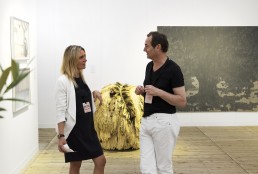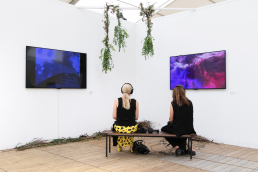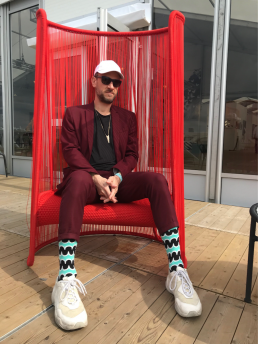Interviews
Interview with Irene Campolmi, Head of the ENTER art fair art program.

"They're giving the chance to an artist to unfold their practice, and they trust them. I think trust is such an important word. They trust an artist, that whatever he or she's going to make, it should be fine. They're allowed to do what they want to do."
Interview with Irene Campolmi, Independent Curator and Head of the ENTER art fair art program, An Endless ‘Present’.
You have experience of curating exhibitions for museums and institutions, for a national pavilion for the Venice Biennale, and also of art fairs. How does the experience of making an art program for an art fair distinguish itself from other elements of your practice?
Well, you have to think about every step of the program that you’re creating, from the very practicalities of producing an art piece, and a booth, or a performance, everything. You have to think from A to Z, and that’s sort of the challenge, but also the most interesting part. That’s definitely what I enjoy, because I have to think about the conceptual part as well as the more logistical side. That’s quite exciting, I would say, because that’s a moment in which you also take care of all the needs of the artist. That’s how you try to respond to that.
Given that it is for a commercial rather than an institutional entity, does this alter your approach, or just basically provides a different kind of venue?
I think it provides a different kind of venue, for one reason. Because when we create exhibitions for art institutions, in a way, the art institution gives the recognition to the artist.
You mean endorses the artist somehow?
Kind of. You know, you give the recognition to the artist, and the artist then gets another kind of position in the art market. You get it?
We’re all kind of working within the same industry, I would say, and I’m not saying that I’m pleased to do that, but institutions should withdraw from the role that they have, because they take their responsibility to endorse a certain practice or to highlight the practice of certain artists. And that feeds into another dimension, which is the art market dimension.

So for the Fair to do this, it’s a little bit like what a gallery does. A gallery makes choices, a gallery pays the bills, a gallery maybe takes the risk, and then the museums take the credit.
Kind of like that, but I’m talking within the same context of the art market. It’s something that we need to be honest about when we talk about that. I want to emphasis that art institutions (biennials included) have become a space for highly polished, sellable work for the art market. Irrespective of their public mission the things they show are always highly finished and relatable in some way to the market. So why not conceive an art program for a fair as a space to reflect and test pilot projects and ideas with artists and see if anything develops, a little like the stage before galleries take things on.
For ENTER you have made a program called An Endless ‘Present’. It’s unusual and perhaps even unique in that you have invited artists to participate that contribute in specific ways to your theme, rather than just including artists that are affiliated with the participating galleries. How did this come about, and was this a particular decision that you made?
The first time that I conceived a program for a fair was when I was invited by another fair called Code 2. It was a good chance to show what I can do, what a curator could do within a certain setting that would not be institutional, but that would have some sort of institutional feel. I took the opportunity to work within the art fair as a platform. And I wanted to show that things could be done in different ways, but also very professionally, and conduct research about different things I could stage (if you want to call it that) in different kinds of settings. For artists, I would say you need to give them the chance to do that. For me, the art program allows me to have a temporary platform where I can experiment.


You define an endless present as a commentary on the many meanings and connotations of the word “virtual.” It’s a complex notion, since so much of life now takes place in supposed virtual ways. It’s hard to know what is virtual and what is real. What do you regard as the virtual, and in your mind is there a clearcut definition that has come to the fore, and how in your view does the virtual insulate us or protect us from the present or somehow reflect the present?
I think that we live our present constantly of course, but also an online present—so we live different lives, and that’s fair enough, but we kind of lost track of what is happening in our real life, being consumed instead by what is happening in our personas, or our virtual lives, which is either on social media or on websites. I think that we live these sort of discrepancies between what we can actually perform as people and what we can perform as professionals online.
So what I wanted to emphasize with this program was actually this aspect, that the virtual represents just yet another temporality that we live every day, but we struggle to define. And the idea of reflecting on an endless present was to look at ways our agency, as human beings but also as art professionals, if you want to say it like that, enters into practice.
Do you think it’s part of our reality, or do you think it’s an escape from reality, or just an alternative reality?
I feel it’s an escape and also an alternative reality, because even when we see the Amazon forest burning in front of our eyes, and we see petitions to join online, or the #MeToo, or the refugee crisis, we kind of take part in these contingent political issues online, but what is our actual real or daily life action with or for these issues? It’s just not really part of that. Our virtual personas take part in the petition perhaps, but our real person doesn’t really take any proper action. That was sort of the starting point of this reflection on an endless present, because we are constantly acting on our contingent and political issues about which we care, but at the same time, we also feel that every day we don’t know how to act in any real sense.
It’s almost like it helps us to feel involved, but in a real, practical way, we’re not really involved.
I don’t feel we are really involved. No.
"They're giving the chance to an artist to unfold their practice, and they trust them. I think trust is such an important word. They trust an artist, that whatever he or she's going to make, it should be fine. They're allowed to do what they want to do."
Tell us about some of the artists’ projects for the program and how you think they embody or exemplify this theme.
The three projects, performances that we have engaged for the program are three new commissions.
One is by Masbedo, and it’s a performance called Anger, which is really drawn from a recent project that the artists have done with the OGR in Turin and with the Pushkin Museum in Moscow. They are reflecting on how any image that we see online about violence doesn’t affect us as much as in reality. We constantly see violent images in newspapers or online, and our behaviour or the way in which we interact with, or react to, these images is not the same as the feelings or the behaviour that we would have when we would see these things in real life. So their performance is about recording and live streaming violent images, violent actions, and filling the discrepancy between experiencing the violence and seeing them at the same time live streamed on a screen, and really creating this duality.
Then the other performance is by Michael Portnoy. Michael has reflected very much on the language that we use on Instagram or on social media to discuss artistic practices, but also to discuss political and social issues that are affecting or impacting our life and social life, and how we use a different language, a language that is always advertising a political statement but also an artistic statement. So he’s playing very much with this very unconventional language about what we want to advertise even as a political statement or as an ethical statement and what we are actually capable of doing or telling in real life.
Then the last performance is by Helene Nymann. Helene reflects very much on the notion of how much we rely on digital media as a mean of archiving our memories, but also our collective memories as a society. Her question is, what would happen if for some reason we can’t any longer access the digital storage that we have, or how much this will affect us as human beings if we start thinking that everything is stored on our phones or on our hard drive. What are we doing if we lost this kind of archive of information? How is a human being able to recollect these memories or also this information within our bodies and our brains? The artist guides us towards embodying this sort of fish, the Afelia californica, which is a fish that is capable of keeping memory in each part of his or her own body, because it’s a sort of an androgynous organ. She will guide us, for instance, towards understanding what would it mean if we had the memory of our first kiss in our finger. So we’d feel and experience it throughout our entire body, rather than delegating these memories to a digital medium, which is perhaps our phone or our hard drive.
As I mentioned, the performance program is quite experimental, because it’s newly commissioned performances. I thank the artists very much, because they fully engaged in a conversation throughout the past months, and they all of them decided to develop a new performance for this program. I feel very lucky about that, about working with artists that really care about the topic that you present. That’s what I think we connect to the question you were asking before.
I think that the good point of an art program within an art fair, which is a temporary event, is that you feel the temporality, and this temporality also feels like a sort of experimental platform. From the artist using an Instagram account to advertise new performances, or playing with our Instagram or social media language that we use in the artwork, to the artists that are redeveloping an entire performance like Anger, playing with the disconnection that you have between what you experience and what you see, and what is your reaction to that. I feel very lucky that we can play with this temporality of a platform that is there now but will disappear soon. But it allows a new dialogue, or a new arena for ideas to develop future projects. At least they give the chance to unfold thoughts that have been in a studio or in an artist’s mind before a gallery or institutional environment.
I think for me what has been super important is to go beyond the event-based idea of creating a performance and gathering people there to see something and then leave. But it’s also like … yeah, isn’t it this what the galleries are doing? They’re giving the chance to an artist to unfold their practice, and they trust them. I think trust is such an important word. They trust an artist, that whatever he or she’s going to make, it should be fine. They’re allowed to do what they want to do.
I’m also considering an art program for an art fair as not the sort of event-based program where you go and check it out and then leave, but instead where you can feel, “Oh, wow, this is probably rough. It’s probably a bit raw, but it’s new and I can enjoy the potential”. It is a nice feeling of trusting an artist to come up with an idea that he or she had in the studio and to use this platform to unfold it and to experiment.
An art institution gives an artist the space to present a polished work. That already enters in the art market field, because you ask an artist to present a very polished performance. That has to be perfect. So you come and go and see, and it’s like, “Whoa, amazing. Perfect.” But that’s already like pre-buying something that you are sure is going to work. A platform like this fair is experimental by definition. I think that this is the biggest opportunity we have as art practitioners, to create a space where you don’t have to show already done stuff, but where you can test projects, where you can test ideas. If it doesn’t quite work, ok, we tried. We take the responsibility for that!
And the galleries that are taking part are also taking their part in this responsibility; spending money to have a booth; taking the responsibility to represent their artists; taking the time to be there. You can say that this is their job, but it’s not their job. Their job is to work with artists. It’s not just to be part of an art fair. So what they’re really doing is to invest, to test something, which is their relationship with the artist and the projects that actually they want to unfold, and also how they’re going to relate to collectors, or to art institutions, or to the public in general.
I tell you, as an independent curator, the first opportunity that I had to show people that I had ideas, I had a way to connect people, and I could bring people within a same spot at the same time, it was through an art fair. It’s because the art fair take the risk of doing something like that, because, again, if it’s unsuccessful or unresolved then people can forget quite easily. For an art institution, it’s way more difficult, and they don’t have room for missteps in this way.
Art fair live programs are a means to conceive a time-based exhibition -performative, discursive, immersive…whatever makes sense to the overarching theme; they are an experiment which actually are more difficult or problematic to test within an art institution. As an art curator, I think it’s our responsibility to go outside our comfort zone.